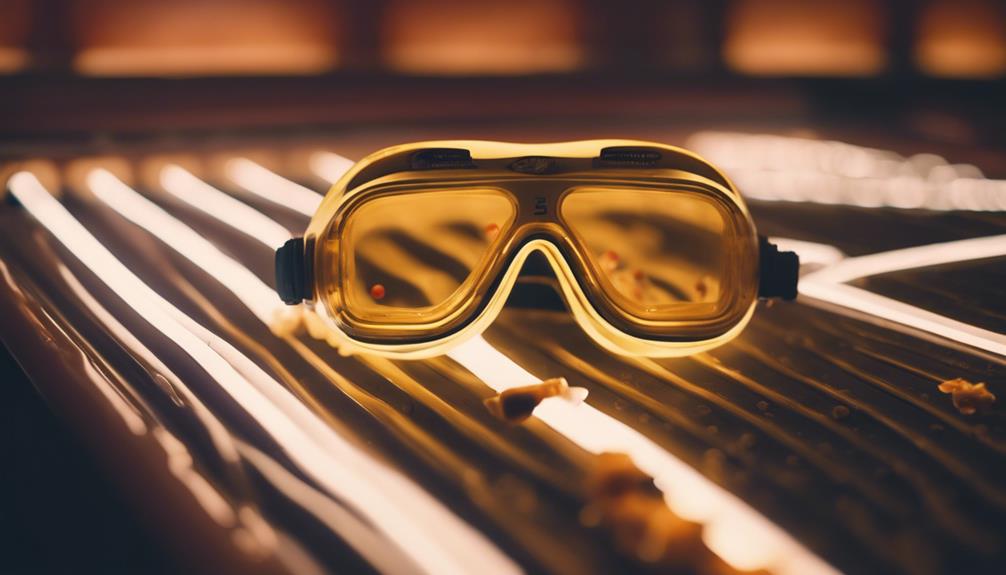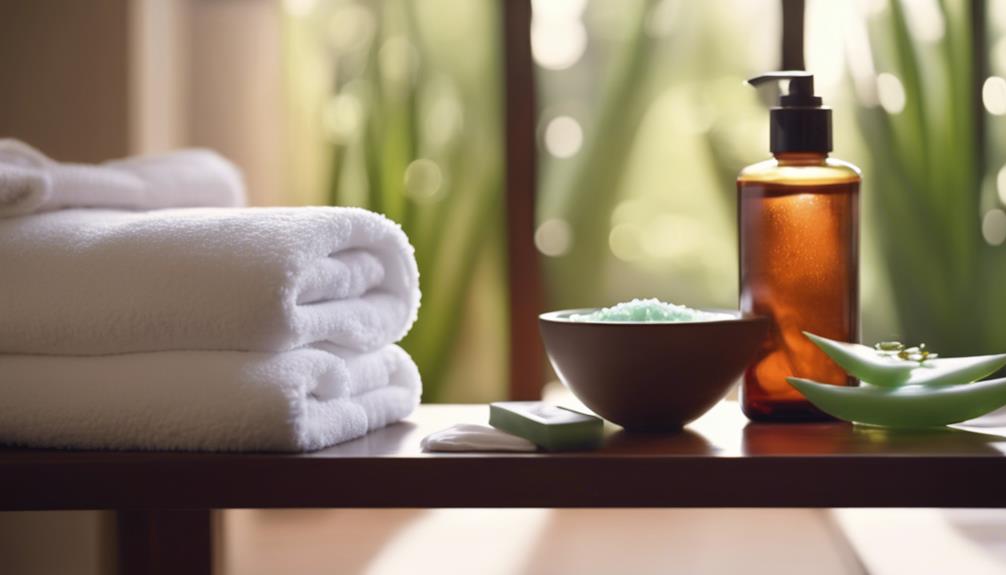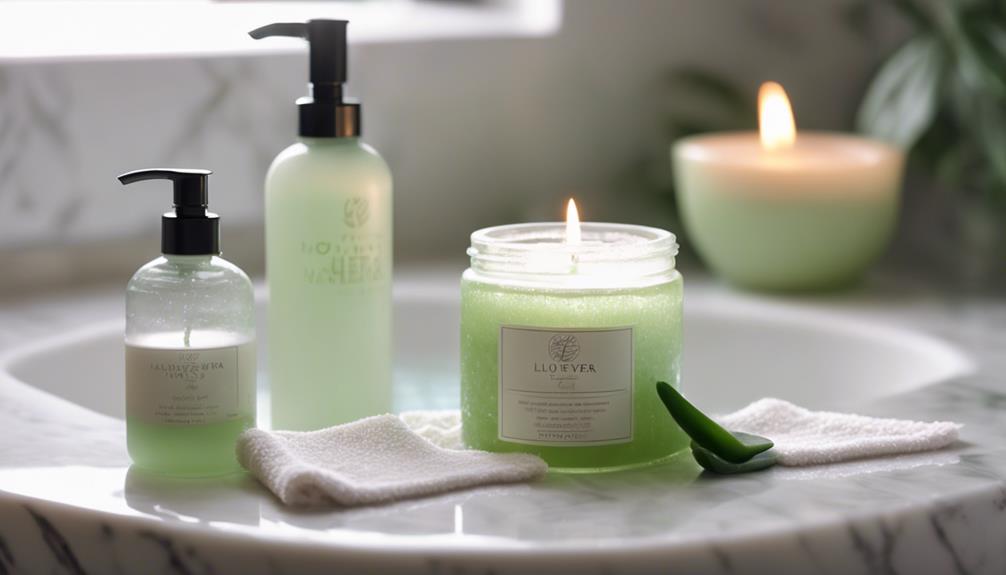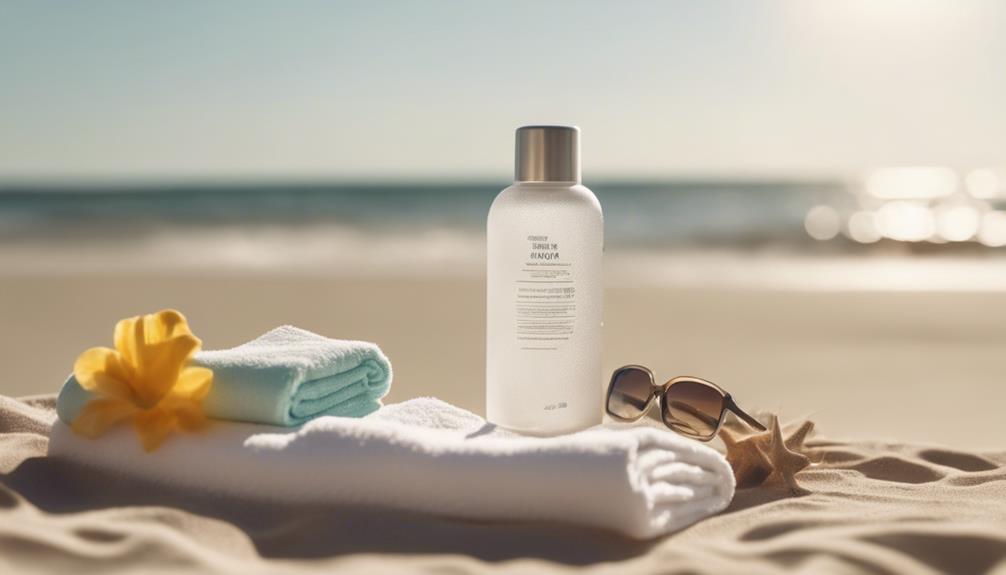To prevent tanning bed infections, the first step is to select a clean facility. Make sure to confirm that the beds and equipment are regularly disinfected. Utilize protective barriers such as disposable sheets and personal undergarments. Applying antimicrobial lotions beforehand can provide an extra layer of protection against germs. Remember to wear FDA-approved eyewear to shield your eyes from harmful UV rays. It’s important to regularly inspect the tanning bed and limit your sessions to minimize infection risks. Following these guidelines will help you stay safe while attaining your desired tan. You may discover additional helpful tips and tricks to further improve your tanning experience.
Key Takeaways
- Choose tanning salons with high cleanliness standards and verified disinfection practices to minimize infection risks.
- Always wear FDA-approved goggles to protect your eyes from harmful UV rays.
- Use disposable sheets or towels on tanning beds to maintain a clean surface during your session.
- Apply antimicrobial lotions before tanning to protect your skin from germs and bacteria.
Choosing Clean Facilities
When you choose a tanning salon, make sure it prioritizes cleanliness to help you avoid infections.
Inspect the facilities for signs of regular disinfection of tanning beds and equipment. You want to see staff actively demonstrating commitment to hygiene practices, as this reflects their dedication to your safety.
Be aware that tanning beds can harbor bacteria, and UV rays don't eliminate germs. Choose salons that not only provide a great tan but also emphasize health and safety.
Regularly check the hygiene practices of the salon, and don't hesitate to ask staff about their cleaning protocols.
Your skin health should always come first, so prioritize salons that maintain high cleanliness standards for a safe tanning experience.
Using Protective Barriers
Using protective barriers is essential for minimizing the risk of infections while tanning.
Always wear eyewear to shield your eyes from harmful UV rays during your session.
Consider using disposable sheets or towels to create a clean surface between your skin and the tanning bed, reducing contact with potentially contaminated surfaces.
Nasal filters can also be beneficial, as they help prevent the inhalation of airborne bacteria.
Additionally, wearing personal barriers like disposable undergarments can enhance your skin protection.
Remember, even if you're avoiding tanning beds, regularly applying sunscreen is vital for safeguarding your skin.
Applying Antimicrobial Lotions

Applying antimicrobial lotions before tanning acts as a protective barrier against potential germs and infections. These lotions, infused with ingredients like tea tree oil or benzalkonium chloride, effectively fight germs on your skin.
For the best results, verify your skin is clean and dry before applying the lotion. This preparation allows the active ingredients to work more effectively, helping to reduce the risk of infections.
Incorporating a thorough cleansing and moisturizing routine can further enhance your skin's defense. If you're unsure about which products to use, consult a dermatologist for tailored recommendations.
Wearing Appropriate Eyewear
Protecting your eyes with FDA-approved goggles is essential to shield them from harmful UV rays while tanning. These goggles must fit snugly and cover your eyes completely to prevent any exposure.
Regular sunglasses won't cut it; they lack the necessary UV protection and may not provide proper coverage for tanning sessions. Treat your eye protection as a critical safety tool, not just a fashion accessory.
Remember, the risks of UV damage can lead to premature aging and other eye-related issues, so don't take shortcuts. Always check that your eyewear is in good condition before each session.
Risks of Tanning Bed Infections

Tanning beds can pose significant risks for infections if not properly cleaned and maintained.
Many people assume the UV rays will kill germs, but that's not the case. Bacteria can thrive on unclean surfaces, leading to skin infections. When you use a tanning bed that hasn't been wiped down, you increase your chances of exposure to harmful pathogens.
Skin irritations and rashes can also develop from prolonged exposure to dirty beds. It's essential to prioritize your skin health over getting a tan.
Always inspect the facility for cleanliness and consider wiping down the bed yourself before lying down. Limit your tanning sessions to avoid irritation and allow your skin to recover to minimize infection risks.
Prevention Strategies
To steer clear of tanning bed infections, you should prioritize hygiene by choosing salons that maintain high cleanliness standards and regularly disinfect their equipment.
Always inspect the facility for cleanliness, ensuring staff follow proper hygiene practices.
Use protective barriers like disposable sheets or towels to create a clean surface between your skin and the tanning bed.
Applying antimicrobial lotions before your session can also help guard against germs, so look for products with effective ingredients.
Don't forget to wear FDA-approved goggles to protect your eyes from harmful UV rays.
Finally, wipe down the tanning bed before use and limit tanning frequency to reduce skin irritation and potential infections.
Staying vigilant is key to enjoying a safe tanning experience.
Related Resources and Tips

Exploring related resources can enhance your tanning experience and help you maintain proper hygiene practices.
Check out 'Best Tips for Cleaning Salon Tanning Beds' for insights on how salons should uphold cleanliness.
'Top Hygiene Hacks for a Flawless Tanning Session' offers essential tips to guarantee you're protected during your sessions.
For a deeper understanding of the importance of cleanliness, read 'Get Bronzed Not Bugged: Tanning Bed Cleanliness.'
If you're looking for eye protection options, '10 Best Tanning Bed Face Covers for UV Protection' is a great resource.
Finally, '3 Key Steps for Pre-Tanning Bed Skin Prep' will guide you on how to prepare your skin effectively.
Utilize these resources to make informed choices as you tan.
Frequently Asked Questions
How Often Should Tanning Beds Be Cleaned by Salons?
Tanning beds should be cleaned after every use to maintain hygiene. You'll want to choose salons that prioritize cleanliness, ensuring staff regularly disinfect equipment and that you can enjoy a safe tanning experience without worries.
Can I Tan Without Using Protective Eyewear?
You shouldn't tan without protective eyewear. UV rays can seriously damage your eyes, leading to long-term issues like cataracts. Always wear FDA-approved goggles to keep your eyes safe while achieving that desired tan.
What Are the Signs of a Tanning Bed Infection?
If you suspect a tanning bed infection, look for redness, swelling, itching, or pus. You might also notice blisters or a rash on your skin. If symptoms appear, consult a healthcare professional for advice.
Is It Safe to Use Tanning Beds With Tattoos?
Imagine a canvas, vibrant yet delicate; your tattoos are art that needs care. Tanning beds can fade colors or cause irritation. If you choose to tan, consider protective measures to keep your ink looking fresh.
How Long Should I Wait Between Tanning Sessions?
You should wait at least 24 to 48 hours between tanning sessions. This allows your skin to recover and reduces the risk of irritation. Always listen to your body and adjust based on how your skin feels.
What are the Essential Tips to Avoid Tanning Bed Infections?
When using tanning beds, it’s important to shield your skin from tanning by following these essential tips to avoid infections. Always use a clean towel to lay on, wear protective eyewear, and thoroughly sanitize the bed before use. Moisturize your skin and avoid tanning if you have any open cuts or sores.
What Precautions Can I Take to Avoid Infections After Using a Tanning Bed?
After using a tanning bed, it’s important to follow the proper tanning bed aftercare tips to avoid infections. Always make sure to clean the tanning bed before and after use, wear protective eyewear, and moisturize your skin to prevent dryness and irritation. These precautions can help keep your skin healthy.
What Are the Best Ways to Prevent Infections from Tanning Beds?
When it comes to guarding against tanning bed germs, there are a few key steps to take. First, always wipe down the bed with disinfectant before use. Secondly, wear protective eyewear to prevent eye infections. Lastly, consider frequent skin checks for any signs of infection or irritation.
Are Tanning Bed Infections Common and How Can I Avoid Them?
Tanning bed infections can occur if the equipment is not properly sanitized. To avoid this, follow essential safe tanning bed tips. Always wear protective eyewear, use a clean towel to lie on, and sanitize the bed before and after use. These simple precautions can help prevent infections.
Conclusion
In summary, keeping safe while tanning is essential for your health.
Did you know that nearly 30% of tanning bed users report skin infections? By choosing clean facilities, using protective barriers, and applying antimicrobial lotions, you can greatly reduce your risk.
Don't forget to wear appropriate eyewear to protect your eyes, too. With these tips, you can enjoy that sun-kissed glow without compromising your well-being.
Stay informed and prioritize your safety while achieving that radiant tan!










